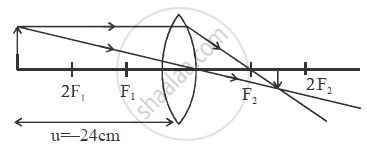Advertisements
Advertisements
प्रश्न
An object is placed at a distance 24 cm in front of a convex lens of focal length 8 cm.
(i) What is the nature of the image so formed?
(ii) Calculate the distance of the image from the lens.
(iii) Calculate the magnification of the image.
उत्तर

(i) As for convex lens, if |u| > | f | then real and inverted image is formed and as |u| > 2| f | then it is diminished.
(ii) `1/v - 1/u = 1 /f`
`1/v = 1/u + 1 /f`
`1/v = (f+u)/(uf)`
`⇒ v =(uf)/(f+u)`
= `((-24)(8))/((8)+(-24))`
= `(-24xx8)/(-16)`
= `(-192)/-16`
= 12 cm
(iii) m = `v/u = 12/-24 = -0.5`
The negative sign signifies an inverted image.
संबंधित प्रश्न
Where must the object be placed for the image formed by a converging lens to be:
real, inverted and larger than the object?
An illuminated object is placed at a distance of 20 cm from a converging lens of focal length 15 cm. The image obtained on the screen is:
(a) upright and magnified
(b) inverted and magnified
(c) inverted and diminished
(d) upright and diminished
Take down this figure into your answer book and complete the path of the ray.
Which type of lens is :
a converging lens, and which is
An object is 2 m from a lens which forms an erect image one-fourth (exactly) the size of the object. Determine the focal length of the lens. What type of lens is this?
A concave lens, if kept at a proper distance from an object, can form its real image.
A concave lens has a focal length 30 cm. Find the position and magnification (m) of the image for an object placed in front of it at distance 30 cm. State whether the image is real or virtual?
Choose the correct alternative and rewrite the following:
Inside water, an air bubble behaves ....................
Convex lens : converging : : concave lens : _______
If the power of a lens is -4.0 D, then it means that the lens is a ______.
